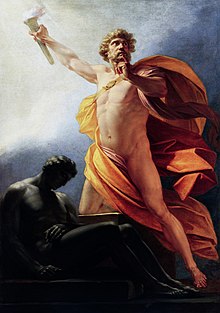Theft of fire
Jump to navigation
Jump to search


Prometheus Brings Fire to Mankind (1817) by Heinrich Füger
The theft of fire for the benefit of humanity is a theme that recurs in many world mythologies. Examples include:
America
- Among various Native American tribes of the Pacific Northwest and First Nations, fire was stolen and given to humans by Coyote, Beaver or Dog.[1]
- In Algonquin myth, Rabbit stole fire from an old man and his two daughters.[2]
- In Cherokee myth, after Possum and Buzzard had failed to steal fire, Grandmother Spider used her web to sneak into the land of light. She stole fire, hiding it in a clay pot.[3]
- According to a Mazatec legend, the opossum spread fire to humanity. Fire fell from a star and an old woman kept if for herself. The opossum took fire from the old woman and carried the flame on its tail, resulting in its hairlessness.[4]
- According to the Muscogees/Creeks, Rabbit stole fire from the Weasels.[5]
- In Ojibwa myth, Nanabozho the hare stole fire and gave it to humans.
- According to some Yukon First Nations people, Crow stole fire from a volcano in the middle of the water.[6]
Eurasia
- According to the Rigveda (3:9.5), the hero Mātariśvan recovered fire, which had been hidden from humanity.
- In Greek mythology, according to Hesiod (Theogony, 565-566 and Works & Days, 50) and Pseudo-Apollodorus (Bibliotheca, 1.7.1), Titan Prometheus steals the heavenly fire for humanity, enabling the progress of civilization.
- In the Book of Enoch, the fallen angels and Azazel teach early humanity to use tools and fire.
- In one of the versions of Georgian myth, Amirani stole fire from metalsmiths, who refused to share it – and knowledge of creating it – with other humans.
- The Vainakh hero Pkharmat brought fire to mankind and was chained to Mount Kazbek as punishment.
Oceania
- In Polynesian myth, Māui stole fire from the Mudhens.[7]
- In the mythology of the Wurundjeri people of Australia, it was the Crow who stole the secret of fire from the Karatgurk women.[8]
See also[edit]
References[edit]
- ^ Judson, Katharine B. Myths and Legends of the Pacific Northwest. Chicago, 1912.
- ^ Alexander, Hartley Burr. The Mythology of All Races. Vol 10: North American. Boston, 1916.
- ^ Erdoes, Richard and Alfonso Ortiz, eds. American Indian Myths and Legends. New York, 1984.
- ^ "La leyenda del tlacuache que trajo el fuego a la humanidad". México Desconocido (in Spanish). 14 December 2018. Retrieved 22 January 2019.
- ^ Swanton, John. "Myths and Tales of the Southeastern Indians." Bureau of American Ethnology Bulletin 88: 1929.
- ^ Janke, Daniel (2008). "How People Got Fire (animated short)" (DVD). National Film Board of Canada. Retrieved 2010-02-10.
- ^ Westervelt, W.D. Legends of Maui – a Demigod of Polynesia, and of His Mother Hina. Honolulu, 1910. Ch. 5.
- ^ Mudrooroo (1994). Aboriginal mythology: An A-Z spanning the history of the Australian Aboriginal people from the earliest legends to the present day. London: Thorsons. pp. 35–36. ISBN 978-1-85538-306-7.
External links[edit]
| Wikisource has the text of the 1911 Encyclopædia Britannica article Prometheus. |
- Reclus, Élisée (1911). . In Chisholm, Hugh (ed.). Encyclopædia Britannica. 10 (11th ed.). Cambridge University Press. pp. 399–401.
- O fogo e as chamas dos mitos (in Portuguese) by Betty Mindlin Essay about the origin of fire, stealing of fire, keeping of fire in different South-American indigenous cultures
| This mythology-related article is a stub. You can help Wikipedia by expanding it. |